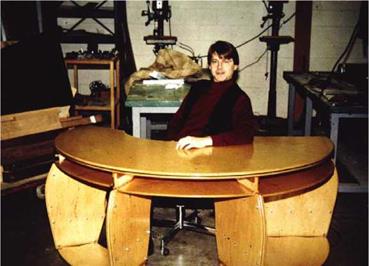Order results from the confluence of ideas present in the conception and development of design. Furniture is nearly always movable, but not all furnishings are designed to move easily. Furniture can be stationary, but not all furnishings are mechanically attached to the floor, wall, or ceiling. Furniture can be adjustable, but not all furnishings are specifically designed to transform from one position into a different position. Most furniture can be taken apart, but not all furnishings are designed and distributed as knock-down or flat – pack. Generally, most furnishings are freestanding; however, not all pieces are seen and experienced in 360 degrees. Freestanding pieces can take advantage of a sculptural and dynamic quality inherent in the nature of form.
The typological orders determined in this book are distinguished by whether or not furniture is:
■ Flat-pack (Ready to Assemble, and Knock-Down)
■ Built-in / Stationary (casework)
■ Freestanding (case goods)
■ Inflatable
■ Transformable
■ Movable
Assembly Required (Ready-to-Assemble and Knock-Down)
Ready-to-assemble (RTA) furniture is distributed and sold in an unassembled state and assembled by the consumer. RTA furniture is also known as flat-pack or knock-down furniture. The Artek Company has produced a series of flat-pack furnishings designed by Alvar Aalto. Most of Artek’s furniture is sold unassembled and shipped throughout the world (see Chapter 4).
 The writing desk shown in Figure 3.38 was designed for easy disassembly and reassembly so that the relatively large writing desk could fit through a narrow doorway when disassembled. The vertical Baltic birch panels and horizontal shelves are mechanically fastened to the underside of the writing desk using pins and dowels. The horizontal shelves and the curvilinear shape of the top help stabilize the desk and resist the lateral forces generated by writing.
The writing desk shown in Figure 3.38 was designed for easy disassembly and reassembly so that the relatively large writing desk could fit through a narrow doorway when disassembled. The vertical Baltic birch panels and horizontal shelves are mechanically fastened to the underside of the writing desk using pins and dowels. The horizontal shelves and the curvilinear shape of the top help stabilize the desk and resist the lateral forces generated by writing.
The Swedish furniture and accessory company IKEA sells unassembled, flat-pack furniture and controls expenses in getting products to market by having customers shop at large distribution outlet centers located throughout the world. The company’s global success is due in part to their unassembled, flat-pack furniture, which significantly helps to control distribution
Figure 3.38 Knock-down writing desk, designed and fabricated by Jim Postell costs and thereby passes the savings °n to its
(1989). Photography by Jim Postell, 1999. consumer.3


